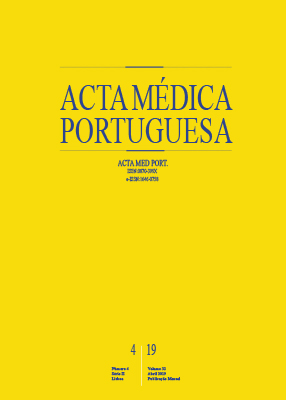Digital Asthenopia: Portuguese Group of Ergophthalmology Survey
DOI:
https://doi.org/10.20344/amp.10942Keywords:
Asthenopia, Ergonomics, Occupational Diseases, Occupational Medicine, OphthalmologyAbstract
Introduction: Given the increasing use of electronic devices, and the increasing number of complaints with its use, we intend to evaluate the prevalence of manifestations of dry eye and ocular fatigue in a population of individuals, who use the computer daily to perform all their professional tasks, as well as to correlate these complaints with the number of hours of digital use as well as their possible improvement with behavioural measures and use of tear drops.
Material and Methods: A total of 77 individuals (154 eyes) were evaluated on two separate days with a 1-month interval. They completed two questionnaires: OSDI and PEG Eye Fatigue. An objective ocular surface assessment was performed: Schirmer test without anesthetic, DR-1a Dry Eye Monitor™, hyperemia evaluation, lacrimal break up, presence of keratitis and lesions in the conjunctiva, as well as near accommodation point and near convergence point. After the first evaluation, the subjects were divided into two groups: group A (< 2 hours of computer working) and group B (> 2 hours of computer working). Some environmental measures to reduce complaints and recommendation of use of artificial tears were explained to the latter.
Results: There was a statistically significant difference in the majority of the parameters evaluated in the group B, in relation to the morning period (group A) - tear film (p = 0.032), hyperemia (p < 0.001), BUT (p < 0.001), keratitis (p < 0.001), conjunctival lesion (p = 0.002) and accommodation point (p < 0.001). In the evaluation – one month later - there were no statistically significant differences in any of the parameters analysed in the group A, and in group B there was a decrease in most parameters at the end of that period - Schirmer test (p = 0.005), lacrimal film (p = 0.022), keratitis (p < 0.001), conjunctival lesion (p = 0.005) and fatigue score (p < 0.001).
Discussion: It was thus possible to show the appearance of ocular fatigue and ocular surface changes with prolonged use of computers (> 2 hours) as well as a significant improvement in symptomatology (subjective assessment) as well as of ocular surface changes (objective evaluation) with the implementation of postural measures, regular breaks and use of lubricants. This is the first study, to the best of our knowledge, of digital asthenopia in which, in addition to the subjective evaluation, the presence of ocular surface modifications (objective assessment) were evaluated and the respective improvement with the aforementioned ergophthalmological measures were evaluated.
Conclusion: This survey highlights the increased overall level of awareness that we need to have to face the rapid and wide-scale changes driven by the emergence of digital technology and, more particularly, its impact on user’s vision and posture. We concluded that the longer we use the electronic devices (more than two hours) the more severe the complaints and rates of ocular surface changes are. Environmental and ocular strategies can attenuate or even eliminate the discomfort caused by this syndrome, and increase professional performance and quality of life.
Downloads
Downloads
Published
How to Cite
Issue
Section
License
All the articles published in the AMP are open access and comply with the requirements of funding agencies or academic institutions. The AMP is governed by the terms of the Creative Commons ‘Attribution – Non-Commercial Use - (CC-BY-NC)’ license, regarding the use by third parties.
It is the author’s responsibility to obtain approval for the reproduction of figures, tables, etc. from other publications.
Upon acceptance of an article for publication, the authors will be asked to complete the ICMJE “Copyright Liability and Copyright Sharing Statement “(http://www.actamedicaportuguesa.com/info/AMP-NormasPublicacao.pdf) and the “Declaration of Potential Conflicts of Interest” (http:// www.icmje.org/conflicts-of-interest). An e-mail will be sent to the corresponding author to acknowledge receipt of the manuscript.
After publication, the authors are authorised to make their articles available in repositories of their institutions of origin, as long as they always mention where they were published and according to the Creative Commons license.









